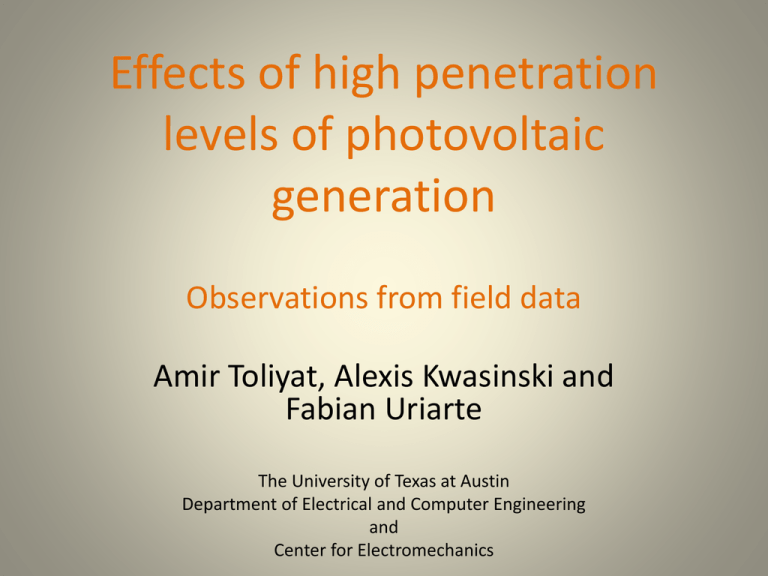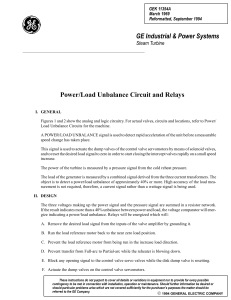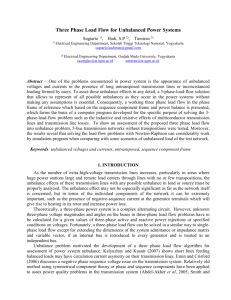
Effects of high penetration
levels of photovoltaic
generation
Observations from field data
Amir Toliyat, Alexis Kwasinski and
Fabian Uriarte
The University of Texas at Austin
Department of Electrical and Computer Engineering
and
Center for Electromechanics
Smart Grid Demonstration Project
WHO?
• Pecan Street Inc.
• Research and development organization
• Focus on PVs, EVs, energy storage,
customer behavior
WHERE?
• Austin, TX, USA
• Mueller neighborhood
Source: Pecan Street Inc.
Scope
• Study of PVs on power factor, voltage rise, voltage unbalance
• Discussion is based on recorded (i.e., real) residential power
consumption and PV generation data
• MATLAB/Simulink computer
model of entire Mueller
distribution system used to
support the analysis
• 735 homes, including
178 grid-tied PV systems
PV generation profiles of 178 homes
Data
• Monitoring equipment capture power consumption and PV
power generation at 1-minute intervals
• Equipment is located between utility meter and home’s
service panel
Household real power usage and generation for a single home on a summer day
in Mueller. Time granularity is in one-minute intervals.
(Source: Pecan Street Inc.)
Distribution System Model
• Two 12.47 kV three-phase feeders emanating from two
different substations
• 94 single-phase pad-mount distribution transformers
• Ratings of 25, 50, 75, 100, or 167 kVA
• 7.2 kV (line-to-ground) primary and a 240 V split-phase
secondary
• SimPowerSystems blockset in MATLAB/Simulink
• Phasor-based simulation type
• 1-minute time step interval to match recorded data
intervals
• Simulation timespan set to 24 hours, or 1,440 minutes
Circuit 3
(phase C)
12.47kV/7.2kV
Circuit 5
(phase C)
Circuit 2
(phase B)
12.47kV/7.2kV
Circuit 1
(phase A)
Circuit 4
(phase B)
Power Factor
• Residential grid-tied PV inverters normally operate at unity
power factor, producing only real power
• A large portion of
demanded real power is
provided from PVs; all of
reactive power provided
from grid
• Utility experiences low
power factors with high
penetration of PVs
Aggregate power flow behind residential distribution
transformer in presence of PV generation
Total consumption and generation of Mueller: 735 homes (178 homes with PV arrays).
• Power factor attains a value as low as 0.465
• Power factor remains below 0.9 between 9:23 and 16:31
Voltage Rise
• Voltage rise is expected when power is injected into
distribution system from load side
• Voltage drops along power lines are reduced
• PVs may adversely affect voltage levels of other customers
• High voltage levels are undesirable
• May reduce equipment lifetime
• May increase power consumption without providing
noticeable improvement in performance
• Voltage levels are required to be within ±5% of nominal voltage
(a)
(b)
Voltage profiles for all 94 transformers (primary sides). (a) 3D view. (b) Front view.
Voltage levels in Mueller are within ±5% of nominal (7.2 kV
line-to-ground) even when PV systems are at their peak power
generation time.
Voltage Unbalance
• Voltage unbalance is a consequence of line voltages not being
equal
• Caused by uneven distribution of single-phase loads on a
three-phase system
• PV sources also contribute to unbalance as they generate
power on only one phase (and, contrary to load’s phaseassignment, PV are integrated to the grid without control to
which phase they are connected)
• Unbalance of 2.5% to 3% or greater is unacceptably high
• Calculated as:
V unb 100
m ax( dV a , dV b , dV c )
V avg
%
(a)
(b)
Voltage unbalance. (a) Three-phase rms voltage simulated at the feeder. (b)
Percent voltage unbalance.
Voltage unbalance in Mueller is well within recommended
range despite high penetration of residential PV generation
Conclusion
• Effects of residential grid-tied PV sources was studied on a power
distribution grid serving an area of Austin, TX
• Study was based entirely on recorded field data
• MATLAB/Simulink computer model was developed to support the
analysis by estimating phase voltages and branch currents
• Although PVs help reduce overall real power supplied by utility, the
power factor decreases to significantly low levels
• Effects of conventional grid-tied PV sources could be severe if
observations from Mueller are extended to a widespread
deployment in an entire city or country
…continued
• Several distribution transformers in Mueller were noted to
experience a reversal in the flow of real power during times when PV
generation was abundant
• Even though voltage rise and voltage unbalance were expected in
Mueller, these variables were maintained within appropriate limits
• These issues may be more noticeable with “weak” power grid
feeders and laterals
• Stability problems may be observed if an area with significant PV
penetration of grid-tied inverters is isolated to form a microgrid
(supported by other power generation source, such a diesel
generators)
• These issues could be avoided if inverters that allow for reactive
power control are used instead











